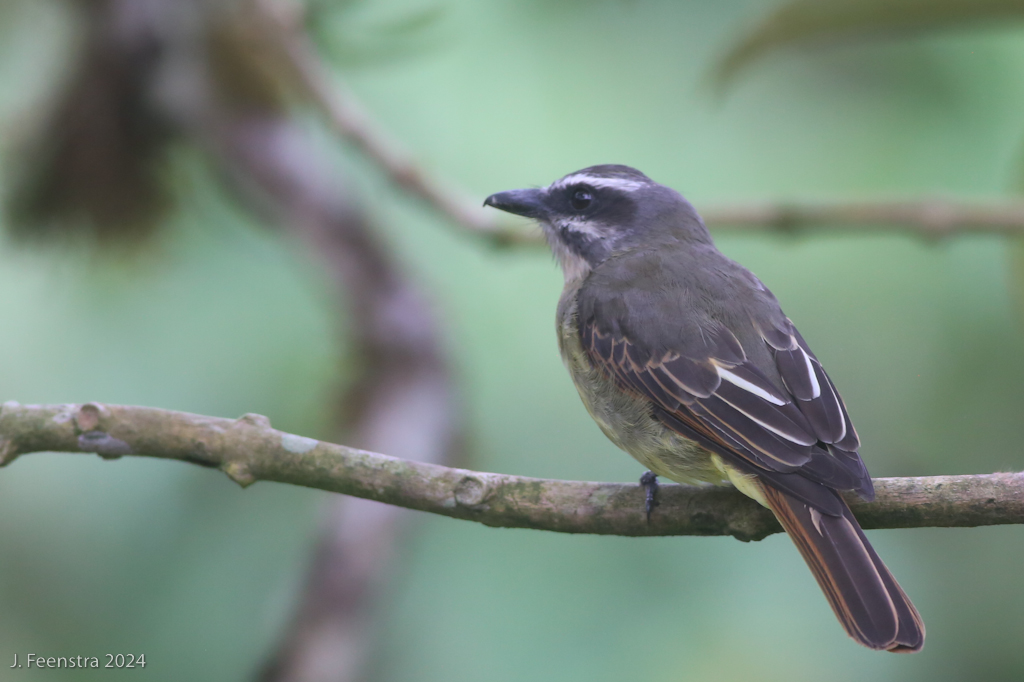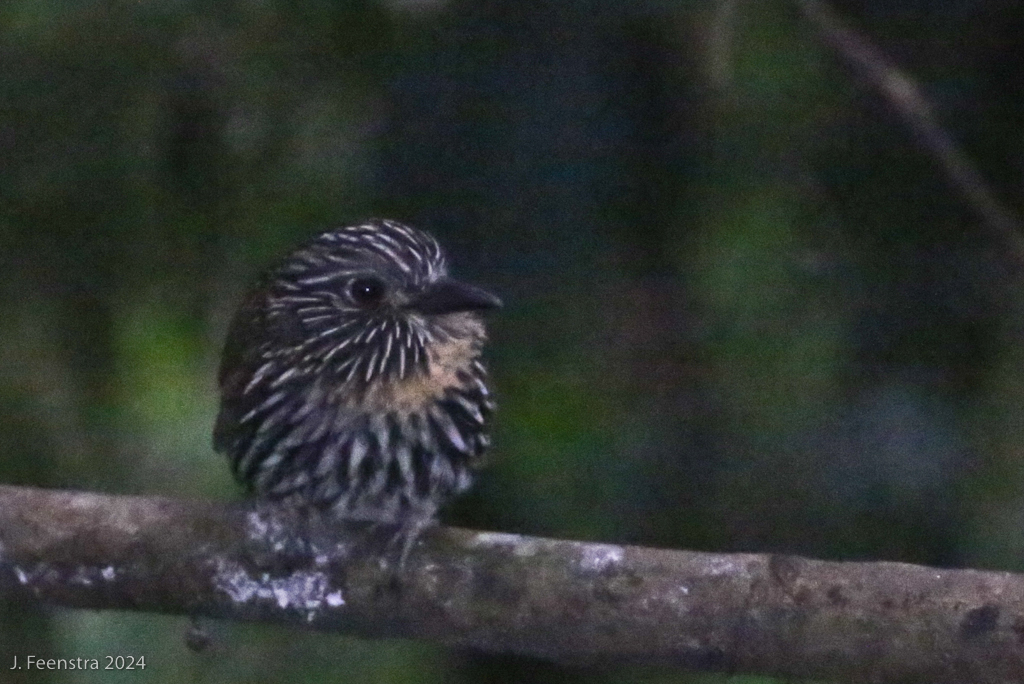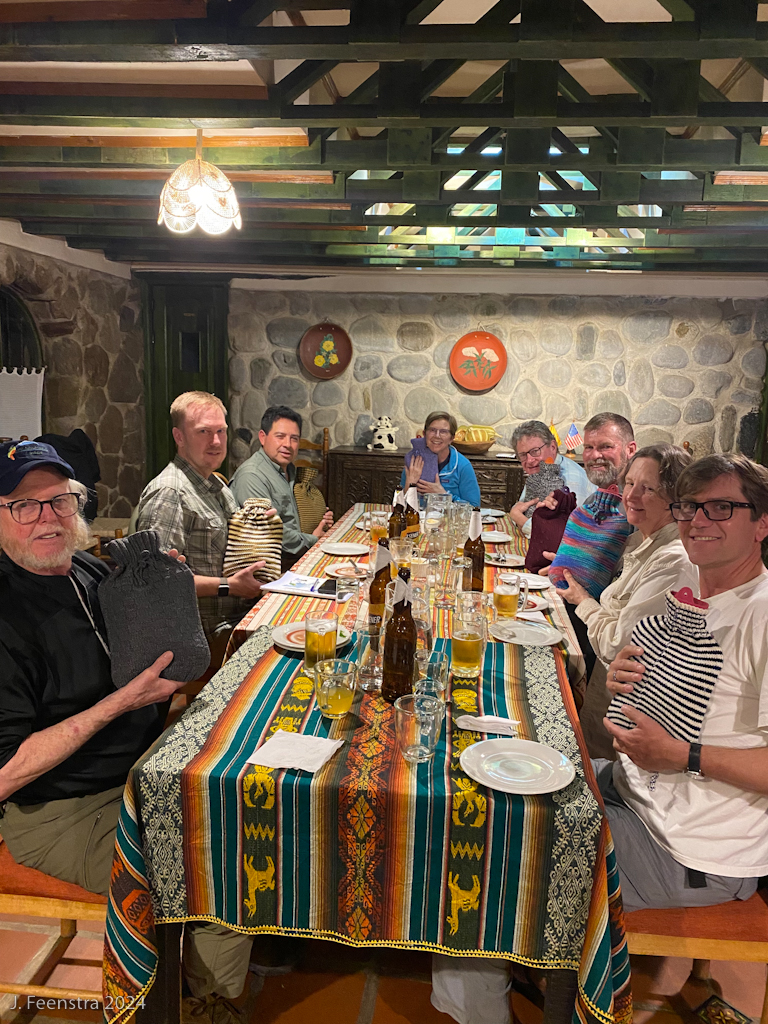WINGS Tour: Ecuador, East Slope, February 2024
6 - 14 February, 2024
The Gang: Don, Maggie, Patrick, Sarah, Scott, Steve, Jon (bird guy), Edwin (el chofer)

With about 3000m of elevation change and habitats as varied as rugged paramo just below the glacier line to foothill rainforest, this tour was a taste of all that the Amazonian slope of the Ecuadorian Andes has to offer. We saw over 300 bird species, including high elevation species like Andean Condor, Black-chested Buzzard-Eagle, and Tawny Antpitta. Lower in the cloud forest we encountered fun things like a sleeping Andean Potoo, Andean Motmot, Torrent Ducks, and little things like Rufous-crowned Tody-Flycatcher and lots of colorful tanagers. Foothill rainforest was awash with birds like Military Macaw, Yellow-throated Toucan, Paradise Tanager, Black-faced Antbird, and (at night) Band-bellied Owl. The hummingbird list topped out at 41 species including the well-named Giant Hummingbird, but also the tiny and endearing Peruvian Racket-tails and ridiculous Wire-crested Thorntails. The area is simply a bottomless pit of birding and this week we did it justice.
To kick off the tour, we went about going to see perhaps Ecuador’s most iconic bird, the Andean Condor. About an hour’s drive away on the cliffs of a gorge roost several of these massive vultures and we were there first thing in the morning to watch them wake up and take to the skies. We ended up seeing a few more over the rest of the day, but having them start our tour was epic. With superlatives on the brain, it was also notable that in the foreground, the world’s largest hummingbird, Giant Hummingbird, was flying and perching. We spent the rest of the day exploring above treeline at Antisana National Park and finding its specialties like Andean Ibis, Andean Lapwing, and loads of Carunculated Caracaras, most of the latter just wandering around chicken-like in the grassy paramo. We also had several encounters with Tawny Antpitta whenever one would wander out into some short grass. It’s always nice to see an antpitta, and to have them so confiding was an added bonus. The setting was also something, vast uninhabited vistas, snow-capped volcanoes, and fascinating alpine plants.










Crossing from the inter-Andean valley to the Amazonian slope involves going over a very high pass, at about 4300m. There’s not that much that lives up there, but the things that do are special. Despite pretty bad weather with temperatures not much above freezing and wet, blowing fog, we gave it a try anyway. We saw Blue-mantled Thornbill, a hummingbird that feeds on the tiniest of alpine flowers. We also found a very accommodating Red-crested Cotinga that showed its red crest as it tossed its head about. Covering the highest part of the area was a pretty brutal slog – memorable for its difficulty and Jameson’s Snipe. But, the real memorable moment was our drive back down to the highway when a Spectacled Bear popped up out of the bushes and looked at us. Seeing South America’s only bear is a very rare treat. Things warmed as we continued our descent. We stopped to chase some Wilson's Snipes, a rare winter vagrant to Ecuador. We then had a hot sit-down lunch, enjoyed some hummingbird feeders, and things were good. We stopped a little further down and found a Torrent Duck family, mom, dad, and two juveniles. Watching them jump into, well, a torrent, is a sight to behold. After another stop or two we got to Cabanas San Isidro, unpacked, had dinner, and watched the Black-banded Owl off the back porch.
After a couple of days of high-elevation birding at or near treeline, we were finally in the thick of tropical forest and the birding was very different this day. We started at a “moth light” on which a nighttime’s worth of moths are eaten by hungry birds sneaking out of the forest at dawn. There were a few things, including such understory skulkers as White-bellied Antpitta and a pair of Chestnut-crowned Brushfinches. We moved from that to birding the forest along the road by the lodge and bumped into a dizzying mixed flock that had us busy for nearly half an hour without moving. It included some fun-to-say birds like Marble-faced Bristle-Tyrant and Oleaginous Hemispingus. Later in the morning we went to some hummingbird feeders and saw diminutive Peruvian Racket-tail, showy Long-tailed Sylph, and more somber Bronzy Incas. It started raining after lunch, but the back porch was roofed and there were still birds to watch, and we saw a Geoffrey’s Daggerbill. After the rain stopped we went back out on the road to work our way uphill seeing a sleeping Andean Potoo, before seeing a couple of Powerful Woodpeckers, and then the tiny, and stunning Rufous-crowned Tody-Flycatchers.








With rain through the much of the day, it could have been better… but, not much. The early morning was pleasant and we spent it on “The Road of Big Cool Birds.” The Road produced today’s hits of four Andean Cock-of-the-rock, three Powerful Woodpeckers, two Golden-headed Quetzals, one Crested Quetzal, one Andean Motmot plus a smattering of smaller, but still kind-of cool birds. Then the rain hit and we decided to use the time to do our drive to lower country. With continuing rain, we skipped a few potential spots and got to Wildsumaco lodge early, then set up at the hummingbird feeders. It was frantic, and busy, and fifteen species were present including Wire-crested Thorntails, Napo Sabrewings, and Black-throated Brilliants. When the rain finally stopped it was still only mid afternoon, so we went up the road to the town’s football field (with a great view of the forest canopy) and spent the time there finding all sorts of things from Scaled Pigeon to Magpie Tanagers, and Red-billed Tyrannulet and Yellow-tufted Woodpeckers. Volcan Sumaco was there, too, looming in the not-too-far distance.


It’s always fun when birding is the whole day and we barely need to drive anywhere. We started watching the moth lights to see what would come in for the harvest. Black-streaked Puffbirds were great, but so were a pair of Black-faced Antbirds, a very pretty bird, and not just for an antbird. We then watched the antpitta feeding, which brought in an Ochre-breasted Antpitta and a Plain-backed Antpitta. While sitting quietly waiting we also got to see an Ecuadorian Piedtail perch on a vine and do a little singing. After that, we spent the rest of the morning working the dark, interior forest. Work it was, but always interesting to be down in the dark understory. The White-crowned Manakins were pretty neat. And, for some reason a Yellow-throated Toucan was down in the lower forest, too. The afternoon got pretty hot and sunny and birding became a challenge, but we still located a Coppery-chested Jacamar (which then allowed us to buy Wildsumaco souvenirs that all have jacamar logos). We saw a few other charismatic things like Paradise Tanagers and less charismatic things like Ecuadorian Tyrannulet, then we were back a the lodge to work on their new Ecuadorian, artisanal beer selection.










The next morning started out pretty wet, so we started avoiding the wet on the back porch of the lodge. Fortunately, there were hummingbirds including a tiny Gorgeted Woodstar somehow steering between the rain drops as it fed on the flowers. It didn’t take long for the rain to let up, so we were off birding the access road, lower in elevation, closer to the highway. We found some more Paradise Tanagers, some Turquoise Tanagers, another Coppery-chested Jacamar, plus we had some Military Macaws fly over, and we saw a Black-eared Fairy, a lowland hummingbird that was new for the tour checklist. After lunch we began our ascent, interrupted by a Fasciated Tiger-Heron in a river – a bird found while driving over a bridge, as they always seem to be. Our destination was Guango Lodge in the upper cloud forest, quite a different climate. We didn’t have too much time to bird, but in that short time we located a small flock including some old faces, plus a Lacrimose Mountain-Tanager, then we found a stately Collared Inca perched along a forest trail. It was just a taste with the next morning to bring the rest of the show.

The morning show was mostly at the moth light in the rain. There was a flock of Turquoise Jays, then when they left, a flock of Green Jays. A flock of Mountain Caciques was in there, too, and some Andean Guans crashed in. And, sneaking around below were Chestnut-capped Brushfinch, Gray-browed Brushfinch, and Pale-naped Brushfinch. What we didn’t know then was that it was going to rain pretty much the whole day. It made some things harder, like finding flocks and extended alpine hikes, but we managed. We did even find a pretty nice flock with Buff-breasted Mountain-Tanager and a group of Black-backed Bush Tanagers. We did the alpine hike, too. Pretty nasty, but found Jameson’s Snipe again. Once we crossed the pass the weather improved markedly and we had a dry afternoon. It was even good soaring weather and we saw a pair of Black-chested Buzzard-Eagles bringing food to their nest. Then that was it. We couldn’t keep birding and still have dinner, so it was time to wrap it up and head back to Puembo to sum it all up over a good meal.


